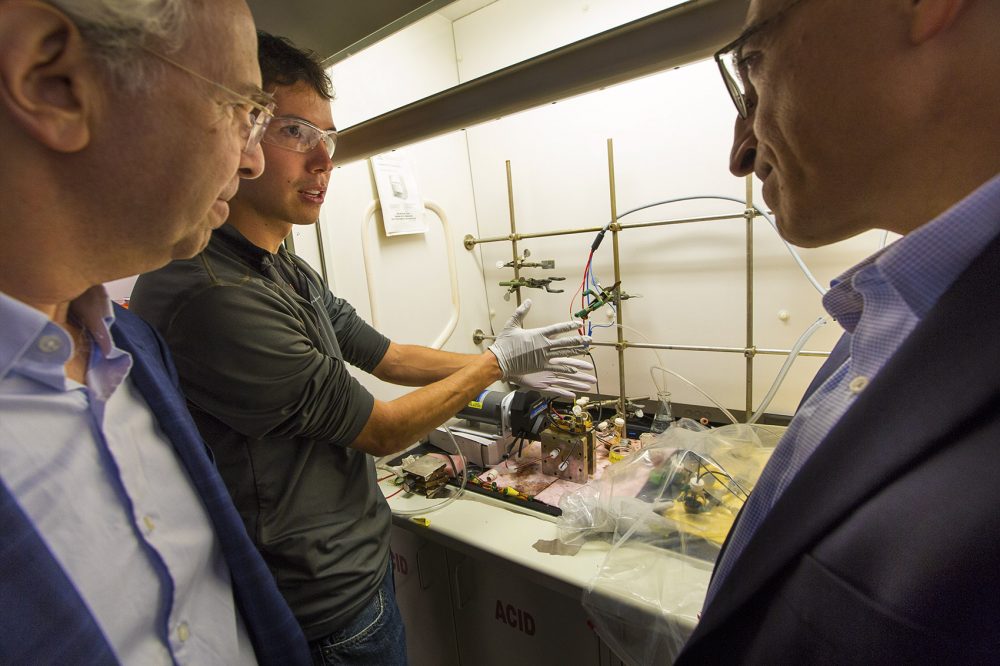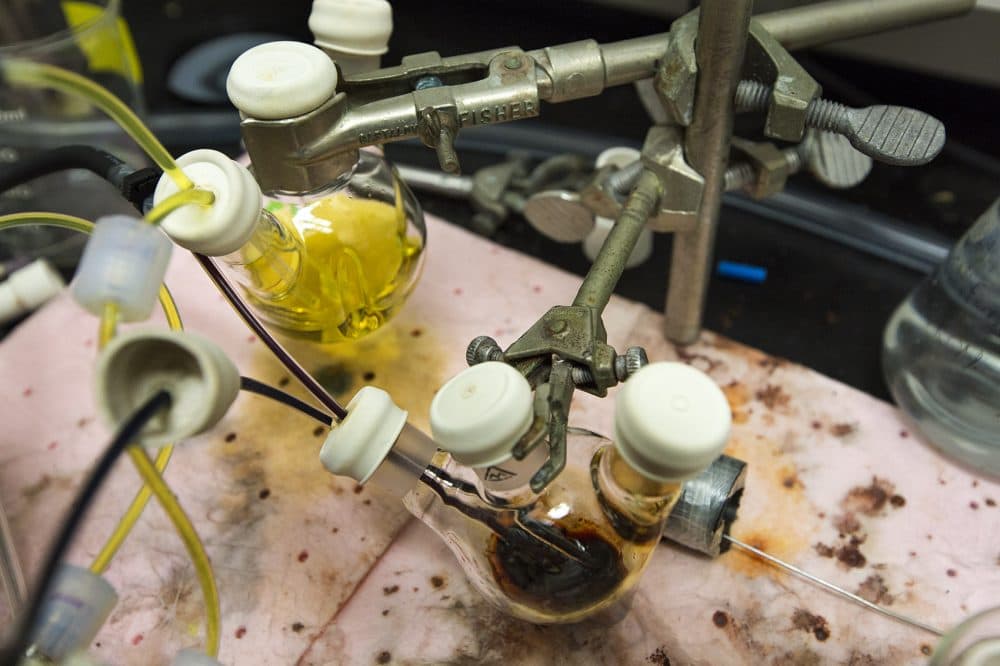Advertisement
This Battery Ingredient Is More Often Used In A Pie Than As A Power Source

Part of a series on new energy storage solutions being developed in Massachusetts
The cost of production is no longer the problem. These days the biggest barrier to getting most of our electricity from solar and wind power is their variability.
"When we have renewable resources, where the sun doesn't always shine, the wind doesn't blow, we need something to back that up," says Judith Judson, head of the Massachusetts Department of Energy Resources. She believes batteries can be a game changer.
Judson recently announced that electric companies in the state will have to install battery systems that can store and release huge amounts of energy.
Being able to do it quickly, cheaply and safely is considered the renewable energy holy grail, and scientists at Harvard University are hot on the trail.
"I think we have a fighting chance of delivering on that 'holy grail' within a decade," says Michael Aziz, a Harvard professor of materials and energy technologies who has tested tens of thousands of compounds for his new battery.
One ingredient, however, is commonly thought to be more at home in a pie than as a power source.
'A Rhubarb Battery'
Harvard grad student Andrew Wong lifts up the plastic laboratory safety hood and adjusts beakers filled with yellow and red liquids. Then he turns on a pump to power his experiment.
"The second I start running this, you can actually see color changes, you'll see it turn really dark, and that's because of some of the properties of the organic molecules," Wong says.
This small, experimental energy storage system looks and works nothing like your typical household battery. Here, the electro-chemical ingredients are dissolved in water and stored in beakers. When those electrolytic solutions flow near each other they create an electric charge.
"And then one of the questions is: How do you take these novel chemistries and then maximize their performance?" Wong explains.

Flow batteries have been around for 40 years. They use metals that react to generate electricity. But Harvard professors Aziz and Roy Gordon teamed up to produce power from organic molecules. They started using a class of compounds known as quinones. The name sounds exotic, but finding them is as easy as pie: rhubarb pie.
"The function of these molecules in rhubarb is to store and transfer energy," Gordon says.
"The press picked up on that and called it a rhubarb battery," laughs Aziz. "We prefer to call it an organic megaflow battery."
The idea of using organic molecules, like those in rhubarb, is new, but Gordon says it's based on a very old technology.
"Biology suggests that that's where we ended up after a billion years of evolution, using these organic molecules to store the energy in our bodies," Gordon says.
Advertisement
Rhubarb -- like all living things, even us — contains carbon. In plants, those carbon-containing quinone molecules are found in chlorophyll. It's chlorophyll that drives photosynthesis by picking up and giving off electrons, over and over again. And Aziz says, they do it without any sign of wearing out.
"And that's exactly the functionality you want in a battery," he explains. "So we found ways to make them soluble in water, and to change the energies at which they pick up and give off electrons. [We] put it in a battery, and it worked. And we've been developing that idea ever since."
The professors' rhubarb days were a few years ago. Since then, they've evaluated hundreds of thousands of organic compounds to see which ones could store and discharge energy.
"Ninety percent of the compounds that we've made and tested are unsuitable for one reason or another, so we tried to weed them out quickly," explains Gordon.
Big Tanks, Cheap Chemicals
The researchers used mathematical models of chemical structures to determine which were promising. They tried aloe vera and vitamin K. Then the quest for quinones expanded to other kinds of organic molecules to include compounds containing nitrogen, like vitamin B2. Tweak it a bit, and it makes a pretty decent battery.
Gordon says it turns out there may be plenty of cheap and easily found organic chemical feedstocks; the basic starting point for making these carbon-based materials is coal and oil. Though not your typical clean energy fuels, when used in an organic megaflow storage system, they become renewable resources.
"It's not like burning it," Gordon says. "It gets recycled in the batteries and keeps that carbon out of the atmosphere."
And the beauty of organic megaflow batteries, says Aziz, is that to increase the energy output, all you have to do is fill "big, dumb tanks with cheap chemicals."
"We know enough now to be optimistic that the cost, when they're mass produced, of at least a couple of our favorite chemicals, can be very, very low," Aziz says.
The question is: How big an organic megaflow battery storage system would you need, say, to store the electricity generated by the nation's first offshore wind farm, Block Island Wind?
Aziz does the calculations out loud. He comes up with 12,000 cubic meters.
"We're talking about very large storage tanks," he says.
It's about twice the volume as the Goodyear Blimp.
But right now, the lab storage cells are the size of postage stamps, and the electrolyte solutions fit into small beakers. The best experimental battery isn't very powerful.
"Typically about one watt comes out of these batteries," Aziz says, "and if you want to back up a wind turbine then you're at a million watts, and if you want to back up a power plant you're at a billion watts."
Professors Aziz and Gordon are now working on a new chemistry. They can't disclose the details just yet, but they're testing it in their lab.
"You can see the pump pulsing with our new top secret chemical and pushing it out of this reservoir and into the cell," Aziz shows off.
Aziz says the new class of organic molecules they're testing can pick up and give off electrons faster, better, cheaper.
"This is the secret sauce," he adds. "The black thing in the background is the secret sauce. If your eyes have spectrophotometers you might get a hint or two about what it is."
The Harvard researchers expect their research will be published soon. The challenge is to scale up their work and create a cost-effective commercial battery.
The U.S. Department of Energy has set the price and performance target to deliver the best bang for the buck, and meet the renewable energy holy grail.
Aziz believes he and his team are well on their way.
"We have a fighting chance of being below $100 a kilowatt hour," he says, "and if we can do that, it will change the electricity system in this country and a lot of the world."
This segment aired on January 10, 2017.
